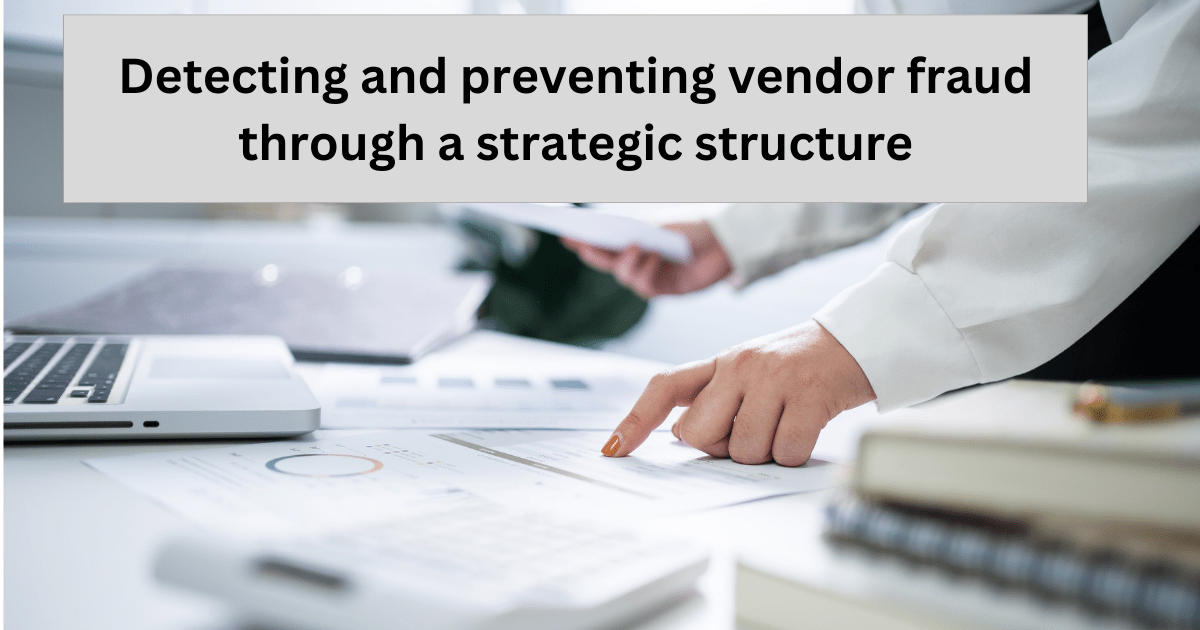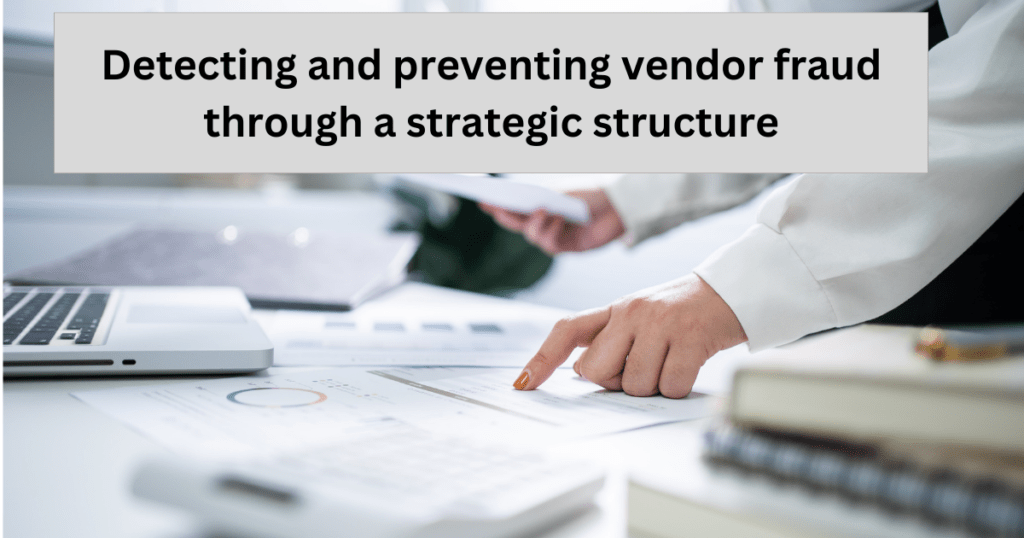
Detecting and Preventing Vendor Fraud Through a Strategic Structure
Dealing with many hazards is a necessary part of operating a business. Involvement with third parties, such as suppliers or even workers, might provide fraud concerns. Vendor fraud is one such widespread scam connected to the accounts payable process.
Organizations must be able to recognize vendor fraud, exercise due diligence, and implement efficient internal controls if they are to effectively resist it.
You’ll discover what vendor fraud is, the various forms it might take, how to spot them, and—most importantly—how to avoid them in this article.
Let’s understand,
Vendor fraud refers to dishonest behavior that attacks a business and is committed by a vendor or by a person posing as a vendor. It nearly usually involves persuading the victim to make erroneous payments of some kind, whether through check fraud, extortion, or invoice manipulation, among other methods.
Vendor fraud aims to steal money from the target business, but it can also be used to acquire access to private data or even carry out sabotage.
As they pose a threat to businesses and are carried out by other organizations, whether they are genuine or not, supplier fraud, billing schemes, false vendor scams, and any other vendor misbehavior and misrepresentation are all sorts of business-to-business fraud.
Who Is Affected by It?
Vendor fraud often has a significant negative impact on small to medium-sized organizations. Since they frequently lack robust controls or checkpoints that can detect and identify such scams, such firms are more vulnerable.
Additionally, smaller businesses with fewer teams of workers rely on a minimum of personnel to manage several AP (Accounts Payable) duties. Therefore, one individual in charge of accepting invoices and authorizing payments may feel pressured to falsify records, which might seriously harm a company’s finances and reputation.
This does not imply that larger businesses are safe. However, given their resources, capacity, and comparatively bigger personnel, they are more likely to implement effective risk management strategies that can reduce the frequency of vendor fraud.
Smaller businesses are particularly vulnerable to vendor fraud if they don’t have the resources and capacity to put tracking procedures and controls in place. Without them, it would be challenging to stop or lessen the several types of fraud that might be done in their AP department.
How Does Vendor Fraud Work?
Vendors and imposters can deceive a business into paying them money it is not due in several ways. However, there are typically four phases in this process:
Reconnaissance and opportunity:
The attacking organization, whether genuine or not, chooses a target and a plan. As a former employee or current business partner of the target, the fraudster may already be familiar with the system and procedures.
Setup, equipment, and software:
The attacker assembles any equipment or décor they may require. For instance, invoicing software, phony email addresses that seem real, or an image-editing tool to alter real bank cheques.
Attacking:
The fraudster launches their attack while assuming the identity of a reliable vendor. This may entail submitting altered or fraudulent invoices, overbilling, or other tactics.
Results and future actions:
If the strategy is effective, the con artist could try it again somewhere else. Additionally, this will demonstrate that the company’s security is inadequate, making them more inclined to attack it again or pass this information along to other thieves.
Types of vendor fraud include:
Vendor fraud can take many different forms and has many different methods of execution. It falls under the categories listed below:
Billing fraud:
It is the practice of employees manipulating payments in one of two ways. Either a fake vendor is used, or additional payments are made using the account of the real vendor.
Check manipulation:
To direct payments to a personal bank account, an employee will falsify or alter information on a vendor’s check.
Taking Bribes:
This kind of fraud is the outcome of an agreement between a vendor and an employee, in which the employee receives personal remittances from the seller in return for more advantages or sales.
Excess Billing:
Overbilling occurs when a vendor sends the business a bill for more goods or services than were originally discussed or agreed upon. This sort of activity can be carried out either secretly or in concert with an employee.
Price fixing:
This kind of fraud takes place when two sellers work together to fix prices at rates that are higher than usual. The purchaser/company is therefore compelled, regardless of the vendor, to pay greater pricing. Employees may be used by vendors as internal sources to get sensitive information about budgets.
Bid rigging:
It is a frequent kind of fraud in which two or more suppliers and employees work together to rig the bidding process so that the highest bidder receives the contract. The employee who encouraged and helped with the scam will be properly reimbursed.
Cyber fraud:
Probably the hardest to spot, these examples of vendor fraud are carried out by unidentified, unauthorized individuals who have no relationship with the organization or the vendor.
Here, other parties can manipulate a vendor’s account and redirect funds to their accounts. Since the entire transaction is conducted electronically, organizations have a tougher time detecting and preventing fraud.
Now,
Detecting and Preventing Vendor Fraud through strategic structure:
Although difficult, vendor fraud may be found and stopped. Stronger controls and procedures can help to a great extent in preventing incidents of vendor fraud once you have identified the critical areas where there is a lack of control. Let’s examine the various controls that may be put in place in a company to stop vendor fraud.
Effective Vendor Management:
Having an efficient vendor management system is the first step in defeating vendor fraud schemes. With such a system in place, your business will find it simpler to effectively manage vendor risk, thereby lowering the likelihood of fraud.
Regularly Audit Your Vendors:
Regular vendor audits can protect your business from significant financial losses brought on by fraud schemes. Work your way through the vendor master files starting with the first one.
A Multi-Level Payment Approval Process should be used:
In businesses where just one employee reviews vendor bills, vendor fraud abounds. Therefore, to avoid it, invoices should be reviewed by two or more staff members from diverse management levels and divisions.
Utilize the technique of invoice matching:
When properly implemented, invoice matching can help keep the occurrence of fraud to a minimum. It is a method that entails comparing financial records like purchase orders, payment receipts, inspection slips, etc. with invoices given by vendors.
Rotate Employees:
Often, one or more employees are required to let a fraudulent plan run smoothly and undetected. Employees in the accounting and procurement departments are typically more likely to be involved in such scams.
Regularly Check Your Employees’ Backgrounds:
An employee might easily commit fraud if they are linked to or married to a vendor. Regular background checks on personnel against your vendors are the only way to combat that. For this, you can alos use call tracking software or tools that will provide you with complete detail of every call that has been made using your business’ identity.
Conclusion:
Nevertheless, there are a lot of practical measures to lower your risk of vendor fraud. A multi-level payment procedure, invoice matching, and ongoing staff turnover are all necessary for efficient vendor management.
Organizations might also decide to hire an expert. To become that kind of expert, understand and gain knowledge of vendor fraud with the Academy of Internal Audit. You may save time and money by using certified fraud examiners to conduct quarterly or yearly vendor audits.

















